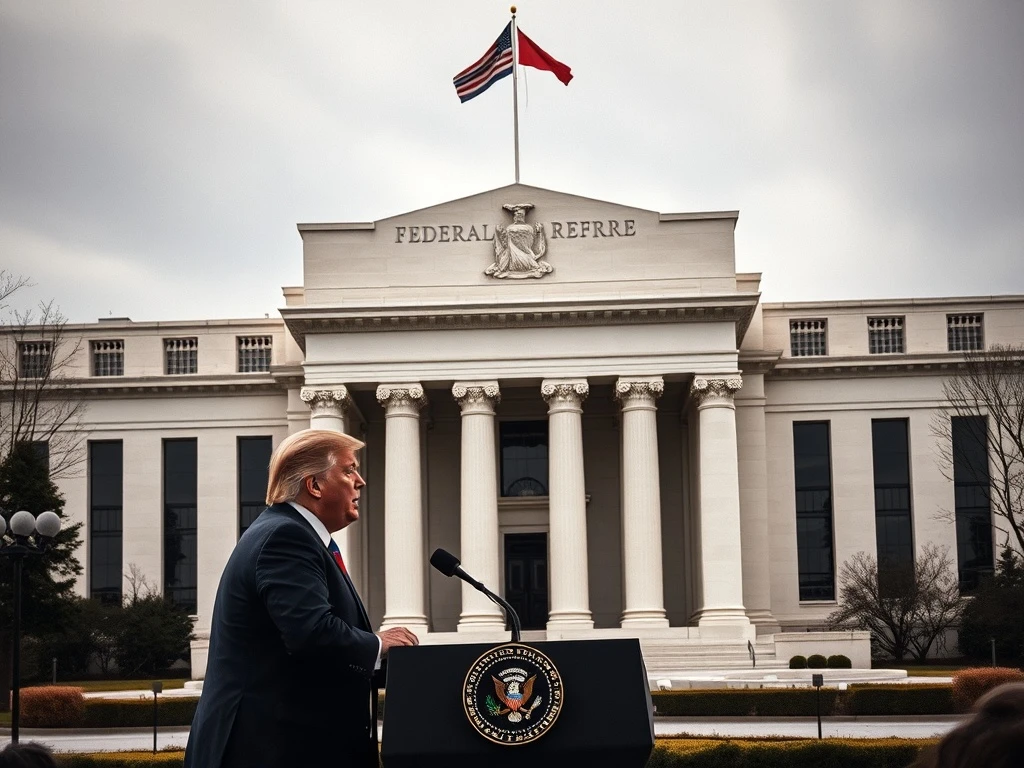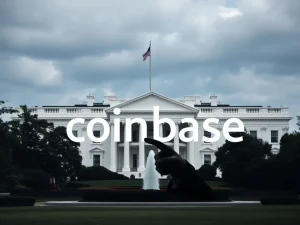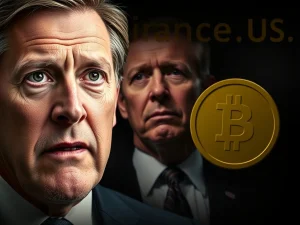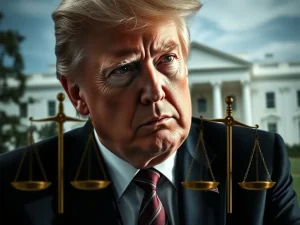Trump Slams Fed’s Extravagant $2.5B Renovation Amid Intense Political Firestorm

When a U.S. President steps into the hallowed halls of the Federal Reserve, it’s rarely a quiet affair. But President Donald Trump’s recent visit was far from conventional, transforming into a public confrontation that intensified scrutiny on the central bank’s operations and its leader, Jerome Powell. This wasn’t just a courtesy call; it was a direct challenge, particularly aimed at the Fed’s controversial $2.5 billion renovation project. For anyone tracking the interplay between politics and financial markets, this incident offers a compelling look at the delicate balance of power and the implications for future economic policy.
Trump Fed Confrontation: A Rare Presidential Showdown
President Donald Trump’s visit to the Federal Reserve headquarters was, by historical standards, an exceptionally rare event. Only three other U.S. presidents—Roosevelt (1937), Ford (1975), and Bush (2006)—had made such a trip, each under distinct circumstances. Trump’s visit, however, stood out for its overtly political tone, quickly escalating into a public lambasting of the Fed’s spending practices and its Chairman, Jerome Powell.
During his address, Trump didn’t mince words, directly criticizing the ongoing $2.5 billion renovation project. He labeled it wasteful and misaligned with the nation’s economic priorities, suggesting it was an example of ‘bureaucratic prestige’ taking precedence over public interest. This public display of disapproval underscored the ongoing tension between the White House and the independent central bank, raising questions about institutional autonomy and accountability.
Unpacking the Federal Reserve’s $2.5 Billion Renovation Costs
The core of Trump’s criticism revolved around the Federal Reserve’s massive $2.5 billion renovation project. This ambitious undertaking focuses on restoring two 19th-century buildings in Washington, D.C. While the Fed defends the project as essential for modernizing infrastructure and preserving historical assets, its hefty price tag has drawn sharp criticism, especially from Trump and his allies.
Key points of contention regarding the renovation costs include:
- Cost-Effectiveness: Reports suggest that some Fed staff privately acknowledged that constructing entirely new facilities might have been cheaper than preserving and extensively renovating the aging structures. This detail fueled accusations of financial mismanagement and poor planning.
- Lack of Transparency: Trump highlighted what he perceived as delayed public disclosure of renovation costs during a press briefing, citing it as evidence of a lack of transparency from the Fed. This perceived opaqueness further eroded trust and fueled public skepticism.
- Prioritization Debate: Critics argue that such a significant expenditure on a building project undermines the Fed’s core mandate of managing inflation and employment, especially during periods of economic uncertainty. Trump has consistently pushed for lower interest rates, framing the renovation as a distraction from these crucial economic objectives.
The optics of a taxpayer-funded overhaul, particularly amid broader economic concerns, have made the project a politically volatile issue, providing ample ammunition for the Fed’s critics.
Jerome Powell Under Fire: Political Tensions Escalate
The visit intensified the already strained relationship between President Trump and Federal Reserve Chairman Jerome Powell. Trump, who nominated Powell in 2017, has been a vocal critic of his leadership, particularly regarding interest rate policy. The renovation project became a new front in this ongoing battle, with the White House framing its management as a potential legal basis to challenge Powell’s tenure.
While no formal legal action has been announced, Trump’s allies have suggested that the project’s management could be scrutinized under federal procurement laws. This aligns with broader efforts to question Powell’s decisions and leadership, creating an environment of heightened political pressure on the independent central bank.
The implications of this escalating political tension are significant. While the Fed’s statutory independence is a crucial safeguard against direct political interference, public challenges from the executive branch risk eroding institutional confidence. The ability of the Federal Reserve to maintain its credibility hinges on its perceived adherence to its core mandate, free from political pressures.
Economic Policy Implications: A Broader Impact?
Beyond the immediate political skirmish, the confrontation carries significant implications for U.S. economic policy. Global markets closely monitor any signs of instability in U.S. monetary policy, and direct presidential criticism of the Fed can introduce uncertainty.
The Federal Reserve’s primary objectives are price stability and maximum employment. Its independence is designed to allow it to make decisions based on economic data and analysis, rather than short-term political expediency. However, Trump’s sustained criticism risks framing the institution as out of touch with public sentiment or even as a political adversary. This perception, whether accurate or not, can impact market confidence and the effectiveness of monetary policy tools.
This confrontation serves as a critical test of the boundaries of executive influence over an independent agency. The Fed’s capacity to navigate these political waters while staying true to its mandate is crucial for maintaining both domestic and international trust in the U.S. financial system.
What’s Next for the Fed and Government Spending?
The Trump Fed confrontation over the renovation costs highlights a broader debate about government spending and accountability. While the immediate focus is on the Federal Reserve, the underlying questions about the efficient use of taxpayer money and the transparency of large-scale public projects resonate across various government agencies.
For the Federal Reserve, the challenge lies in balancing its need for modern infrastructure with public perception and political scrutiny. Moving forward, the institution may face increased pressure to provide more detailed justifications and transparent reporting on its expenditures, particularly for high-profile projects. This incident underscores that even independent bodies are not immune to political pressures and public demands for accountability.
The implications extend beyond the current administration, setting a precedent for how future presidents might engage with independent agencies. The ability of these institutions to maintain their operational independence while addressing legitimate concerns about fiscal responsibility will be key to their long-term effectiveness and public trust.
Conclusion: A Watershed Moment for Central Bank Independence
President Trump’s extraordinary visit to the Federal Reserve headquarters and his sharp criticism of its $2.5 billion renovation project represent more than just a political spat over renovation costs. It’s a vivid illustration of the escalating tensions between the executive branch and a cornerstone of U.S. economic stability. With Jerome Powell’s leadership under direct challenge and the spotlight firmly on the Fed’s spending, this episode underscores the fragile yet vital independence of the central bank. As the nation navigates complex economic landscapes, the ability of institutions like the Federal Reserve to operate free from undue political influence remains paramount for sound economic policy and market confidence. This confrontation will undoubtedly be remembered as a significant moment in the ongoing debate about government accountability and the autonomy of critical financial institutions.
Frequently Asked Questions (FAQs)
Q1: Why was President Trump’s visit to the Federal Reserve so unusual?
A1: President Trump’s visit was historically rare, being only the fourth time a U.S. President has visited the Federal Reserve headquarters. What made it particularly unusual was its overtly political nature, as he used the occasion to publicly criticize the Fed’s spending and Chairman Jerome Powell, rather than a traditional consultative or ceremonial visit.
Q2: What is the Federal Reserve’s $2.5 billion renovation project about?
A2: The $2.5 billion project involves the extensive renovation and restoration of two 19th-century buildings in Washington, D.C., that are part of the Federal Reserve’s campus. The Fed states it’s necessary for modernizing infrastructure, improving security, and preserving historical structures, but critics, including President Trump, have labeled it wasteful due to its high cost.
Q3: How does this confrontation impact Jerome Powell’s position as Fed Chairman?
A3: The confrontation significantly escalates political pressure on Jerome Powell. While his position is legally protected by the Fed’s independence, President Trump’s public criticism and hints from allies about scrutinizing the renovation under procurement laws create an environment of intense scrutiny and potential challenges to his leadership and decision-making.
Q4: What are the broader implications of this political tension for U.S. economic policy?
A4: The tension risks eroding public and market confidence in the Federal Reserve’s independence. If the central bank is perceived as being influenced by political pressures rather than solely by economic data, it could undermine the effectiveness of its monetary policy decisions, potentially leading to market instability and impacting global perceptions of U.S. financial stability.
Q5: Is the Federal Reserve truly independent from political influence?
A5: The Federal Reserve is designed to be statutorily independent, meaning its decisions on monetary policy are intended to be free from direct political interference from the executive or legislative branches. However, public criticism and political pressure, as seen in this instance, can test the boundaries of this independence and influence public perception, even if they don’t directly alter policy decisions.








